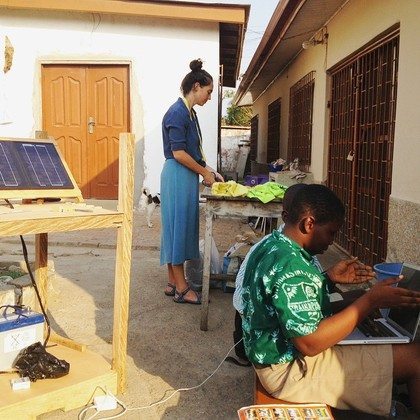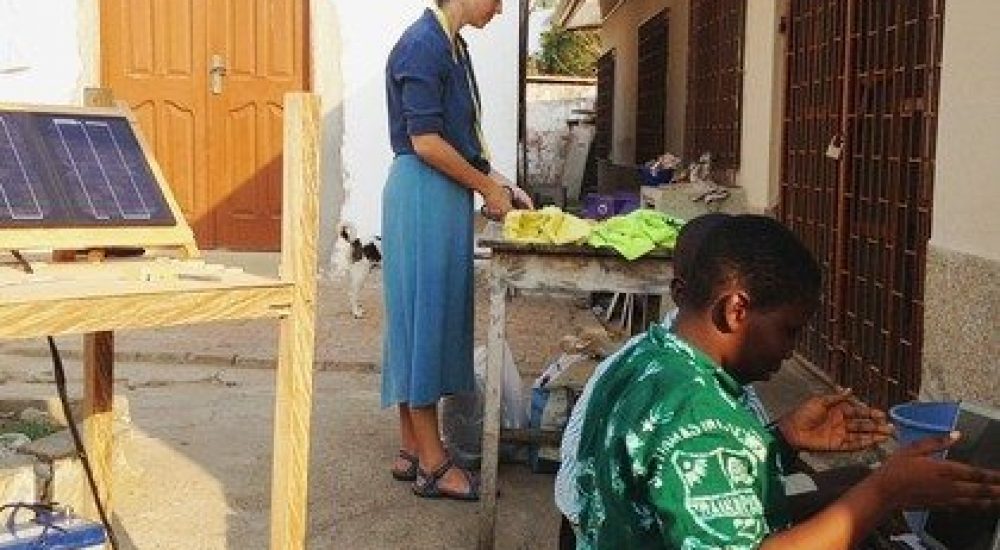This blog is an additional follow-up resource from J. Branson Skinner and Liz Ricketts’ blog, Experience Inspires Love, originally posted on the Breakfast Club. This blog is a part of our ongoing partnership with Asia Society.
The #Collectofus Global Leaders program, part of The OR Network, connects students in Accra, Ghana; Vaalwater, South Africa; Detroit, Michigan; Brooklyn, New York; Cincinnati, Ohio; and Washington, D.C. They create and exchange scarves and videos and then interact through an online platform while learning together through a curriculum that explores the clothing students in every location wear regularly.
At the beginning of every year, the conversations we have with our students are like deja vu.
Students in the U.S. are hesitant to ask questions of their peers abroad—they are worried about not asking the right questions. Meanwhile, students in Ghana and South Africa, who we lead through the exact same process, have never expressed such worries or exhibited such hesitancy.
This is an interesting phenomenon that we believe reflects a difference in education systems and the preconceived notions that students develop of one another. For instance, when we first introduce what students are going to do with us over the course of a year, we often hear from our students in the U.S., “Is it OK to ask what their parents do?” or “Can I ask about HIV?” or “Is it bad to ask about food?”
They have also asked if it’s OK to ask their peers in Ghana and South Africa about their favorite colors and the music that they like. It’s clear to us that our students in the U.S. often only know the tragic side of the continent of Africa. They don’t want to ask what they see as difficult questions in a place of tragedy. And they don’t want to ask questions they perceive as too trivial for a place of such struggle.

Students in Accra interact on Collectofus.org with a laptop powered by the solar station that the students themselves built as one of their community actions project through the Collectofus Global Leaders program. In the background Liz prepares textiles for the next day’s lesson.
Our U.S. students know a single story of the continent of Africa. As Chimamanda Adichie says in her now famous TED Talk that we show to all of our students, it’s not that this stereotype of tragedy is wrong, it’s incomplete; family members dying and people going hungry are universal experiences, whether an individual is from Washington, D.C., or Accra, Ghana. The fact that people have favorite colors and enjoy certain types of music is also universal. These are all human things, and they make up the complete story of a people and a place.
And, at the core of our program, we want students to reflect on themselves and what makes us all humans together. What the students in the U.S. see as difficult or trivial questions are exactly what we want our students to ask of one another. So how do we get them to break through their initial trepidation and converse?
Personal, Thoughtful Questions
First, we establish some basic concepts with our middle school students. We discuss the difference between an open and a closed question. If students have to wait weeks for questions and responses from peers abroad, we want the conversations to be meaningful. This is facilitated by asking open questions that call for thoughtful responses. As part of this conversation, we discuss with students what is searchable online. If they can google a question, for instance, “Is it hot in Ghana?” or “Is Washington, D.C., where Barack Obama lives?,” then there is little need to ask it of their peers. This fact pushes students to consider more personal questions that only their peers can answer.
How to Formulate
Next, we establish a rule that for every question a student asks, she has to give her own response to that question. So if a student wants to ask, “What is your favorite sport to play and why?,” she would have to first say, “My favorite sport to play is lacrosse. I like it because it is a combination of other sports that I also enjoy: soccer and hockey. I also really enjoy playing on a team. It’s a great way to make friends, and it pushes me to try harder.” Then, we ask students not to assume that their peers will know what they are talking about. Most students in Ghana have never heard of lacrosse. Likewise, most students in the U.S. have never heard of waakye, a popular food in Ghana that students often mention. So we ask students to explain thoroughly their questions and responses and what they mean by certain words. While both waakye and lacrosse are easily searchable, the act of explaining slows students down and helps them consider perspectives other than their own. After we’ve covered these ground rules and basic concepts, students begin to formulate their questions, writing down both the questions for their peers and their own accompanying responses.
Practice
Before students can record videos or visit our web platform where they have asynchronous conversations with their peers abroad, we have them practice their questions with one another in class. When it comes time to film the first communications across borders, students will interview one another in groups of three. One student operates the camera. One student acts as interviewer using the interviewee’s prepared questions and responses as prompts to begin a conversation. The third student is in front of the camera sharing the scarf that she made for her peer abroad and engaging with the interviewer. We’ve found that this three-person group allows for a natural, unscripted conversation between interviewer and interviewee, often pushing beyond the initial student-scripted questions and responses.
Transformations
Even though students on both sides of the Atlantic go through this same process, it’s not until they receive the scarves and initial videos that their peers made for them that the borders come down and the students really open up. From shy and quiet to singing out loud a favorite song, we have seen students completely transform the moment they watch their peers’ videos and put on their new scarves. The tangible scarf helps form a strong bong: A student sees this scarf as a sign that her peer cares. And the conversation and personal reflection that ensues between peers after the exchange is a strong lesson in the humanity we all share.
Photo credits: The OR Network.
